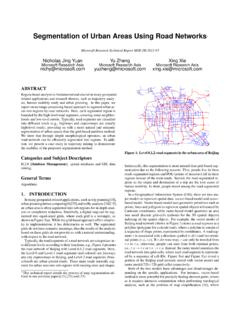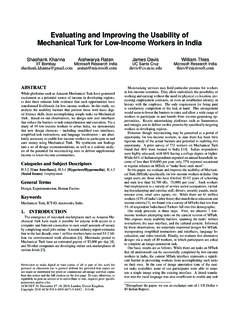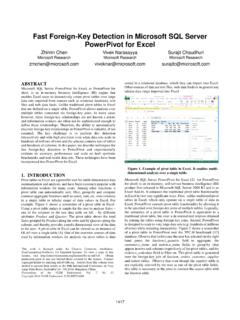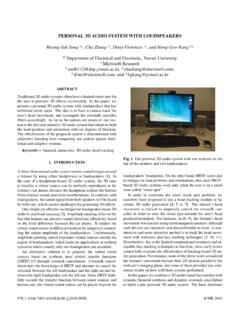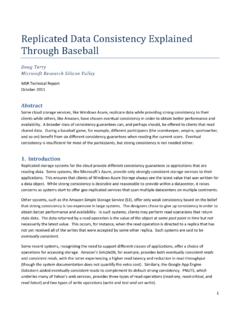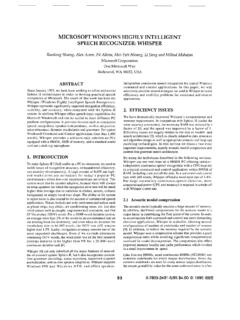Transcription of The Byzantine Generals Problem
1 The Byzantine Generals Problem LESLIE LAMPORT, ROBERT SHOSTAK, and MARSHALL PEASE SRI International Reliable computer systems must handle malfunctioning components that give conflicting information to different parts of the system. This situation can be expressed abstractly in terms of a group of Generals of the Byzantine army camped with their troops around an enemy city. Communicating only by messenger, the Generals must agree upon a common battle plan. However, one or more of them may be traitors who will try to confuse the others. The Problem is to find an algorithm to ensure that the loyal Generals will reach agreement.
2 It is shown that, using only oral messages, this Problem is solvable if and only if more than two-thirds of the Generals are loyal; so a single traitor can confound two loyal Generals . With unforgeable written messages, the Problem is solvable for any number of Generals and possible traitors. Applications of the solutions to reliable computer systems are then discussed. Categories and Subject Descriptors: [Computer-Communication Networks]: Distributed Systems--network operating systems; [Operating Systems]: Communications Management-- network communication; [Operating Systems]: Reliability--fault tolerance general Terms: Algorithms, Reliability Additional Key Words and Phrases: Interactive consistency / 1.
3 INTRODUCTION A reliable computer system must be able to cope with the failure of one or more of its components. A failed component may exhibit a type of behavior that is often overlooked--namely, sending conflicting information to different parts of the system. The Problem of coping with this type of failure is expressed abstractly as the Byzantine Generals Problem . We devote the major part of the paper to a discussion of this abstract Problem and conclude by indicating how our solutions can be used in implementing a reliable computer system. We imagine that several divisions of the Byzantine army are camped outside an enemy city, each division commanded by its own general .
4 The Generals can communicate with one another only by messenger. After observing the enemy, they must decide upon a common plan of action. However, some of the Generals This research was supported in part by the National Aeronautics and Space Administration under contract NAS1-15428 Mod. 3, the Ballistic Missile Defense Systems Command under contract DASG60-78-C-0046, and the Army Research Office under contract DAAG29-79-C-0102. Authors' address: Computer Science Laboratory, SRI International, 333 Ravenswood Avenue, Menlo Park, CA 94025. Permission to copy without fee all or part of this material is granted provided that the copies are not made or distributed for direct commercial advantage, the ACM copyright notice and the title of the publication and its date appear, and notice is given that copying is by permission of the Association for Computing Machinery.
5 To copy otherwise, or to republish, requires a fee and/or specific permission. 1982 ACM 0164-0925/82/0700-0382 $ ACM Transactions on Programming Languages and Systems, Vol. 4, No. 3, July 1982, Pages 382-401. The Byzantine Generals Problem 383 may be traitors, trying to prevent the loyal Generals from reaching agreement. The Generals must have an algorithm to guarantee that A. All loyal Generals decide upon the same plan of action. The loyal Generals will all do what the algorithm says they should, but the traitors may do anything they wish. The algorithm must guarantee condition A regardless of what the traitors do.
6 The loyal Generals should not only reach agreement, but should agree upon a reasonable plan. We therefore also want to insure that B. A small number of traitors cannot cause the loyal Generals to adopt a bad plan. Condition B is hard to formalize, since it requires saying precisely what a bad plan is, and we do not attempt to do so. Instead, we consider how the Generals reach a decision. Each general observes the enemy and communicates his obser- vations to the others. Let v(i) be the information communicated by the ith general . Each general uses some method for combining the values v (1) .. v (n) into a single plan of action, where n is the number of Generals .
7 Condition A is achieved by having all Generals use the same method for combining the infor- mation, and Condition B is achieved by using a robust method. For example, if the only decision to be made is whether to attack or retreat, then v(i) con be general i's opinion of which option is best, and the final decision can be based upon a majority vote among them. A small number of traitors can affect the decision only if the loyal Generals were almost equally divided between the two possibilities, in which case neither decision could be called bad. While this approach may not be the only way to satisfy conditions A and B, it is the only one we know of.
8 It assumes a method by which the Generals communicate their values v (i) to one another. The obvious method is for the ith general to send v (i) by messenger to each other general . However, this does not work, because satisfying condition A requires that every loyal general obtain the same values v(1) .. v(n), and a traitorous general may send different values to different Generals . For condition A to be satisfied, the following must be true: 1. Every loyal general must obtain the same information v (1) .. , v (n). Condition 1 implies that a general cannot necessarily use a value of v(i) obtained directly from the ith general , since a traitorous ith general may send different values to different Generals .
9 This means that unless we are careful, in meeting condition 1 we might introduce the possibility that the Generals use a value of v (i) different from the one sent by the ith general --even though the ith general is loyal. We must not allow this to happen if condition B is to be met. For example, we cannot permit a few traitors to cause the loya~ Generals to base their decision upon the values "retreat",.., "retreat" if every loyal general sent the value "attack". We therefore have the following requirement for each i: 2. If the ith general is loyal, then the value that he sends must be used by every loyal general as the value of v (i).
10 ACM Transactions on Programming Languages and Systems, Vol. 4, No. 3, July 1982. 384 L. Lamport, R. Shostak, and M. Pease We can rewrite condition I as the condition that for every i (whether or not the ith general is loyal), 1'. Any two loyal Generals use the same value of v(i). Conditions 1' and 2 are both conditions on the single value sent by the ith general . We can therefore restrict our consideration to the Problem of how a single general sends his value to the others. We phrase this in terms of a commanding general sending an order to his lieutenants, obtaining the following Problem . Byzantine Generals Problem .
